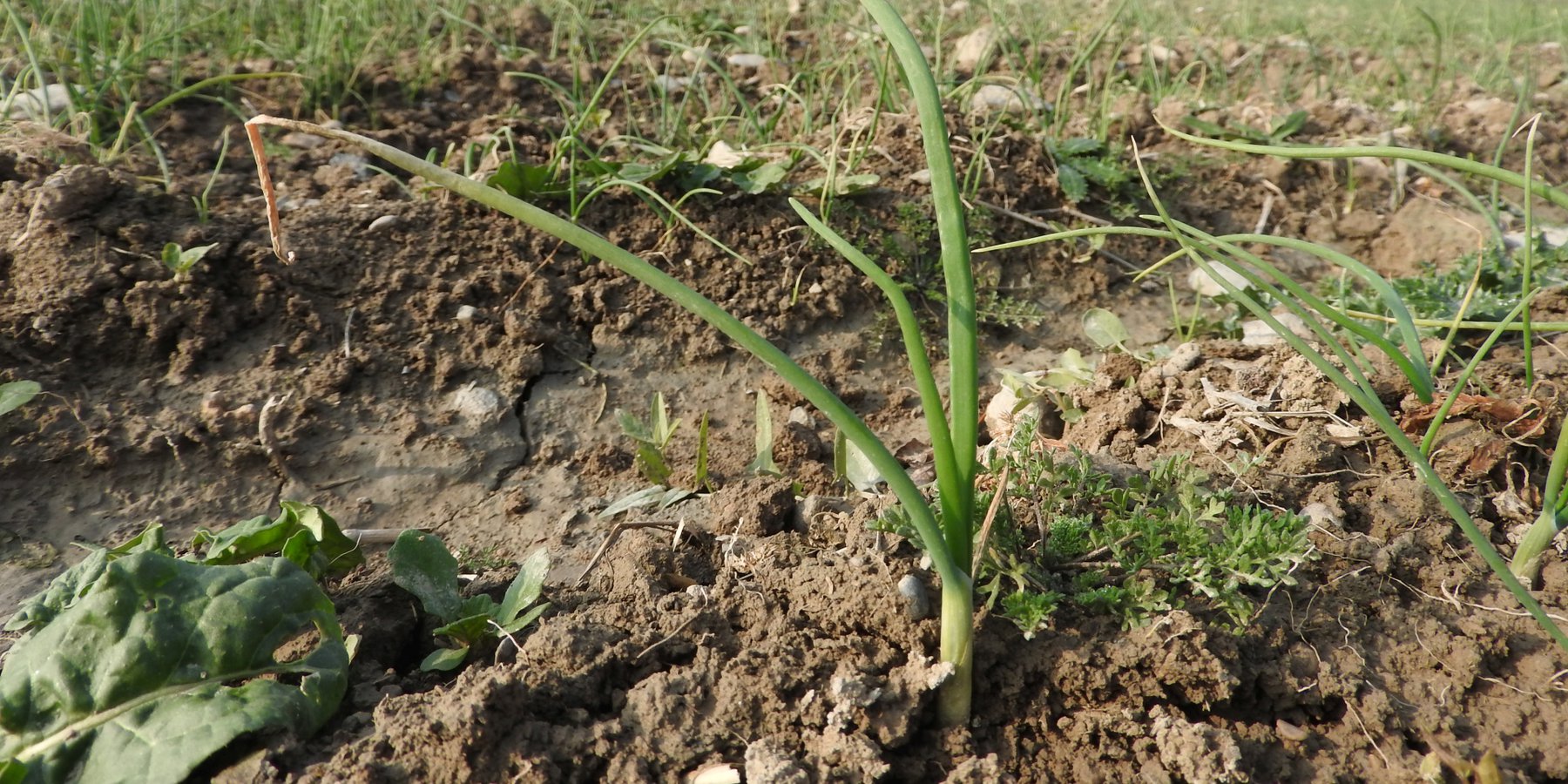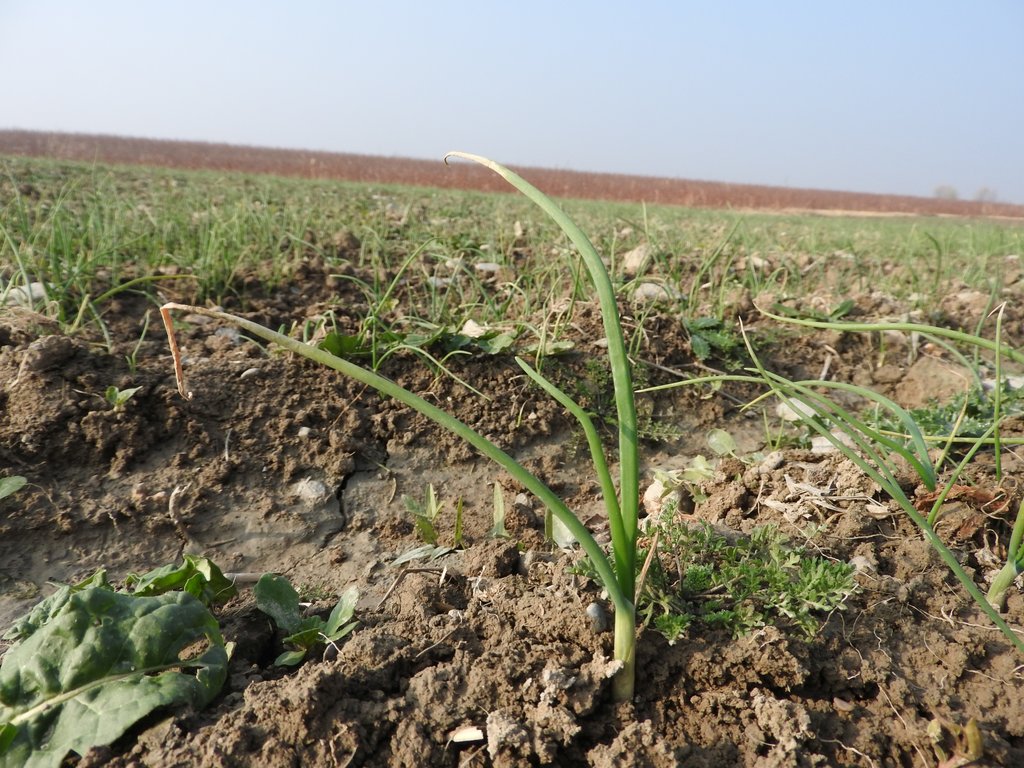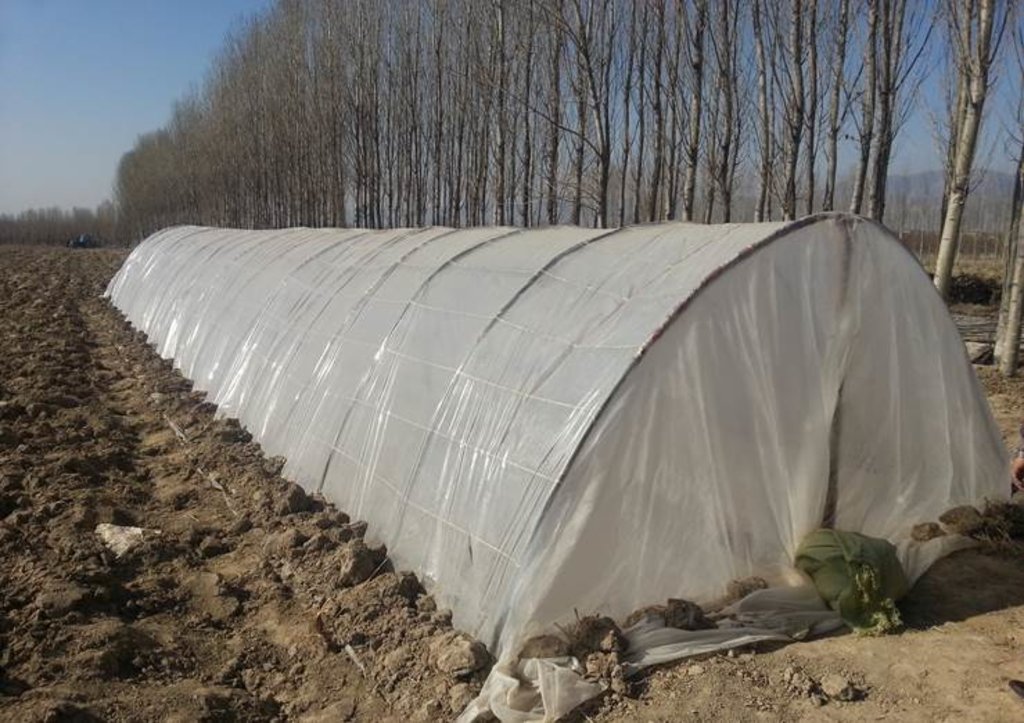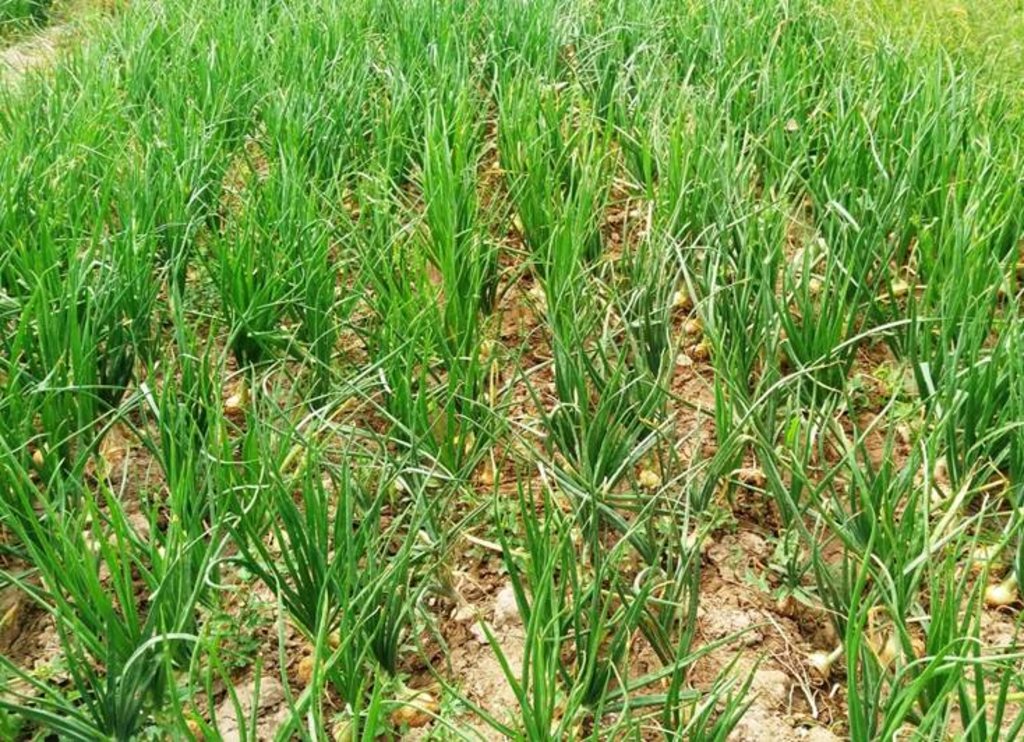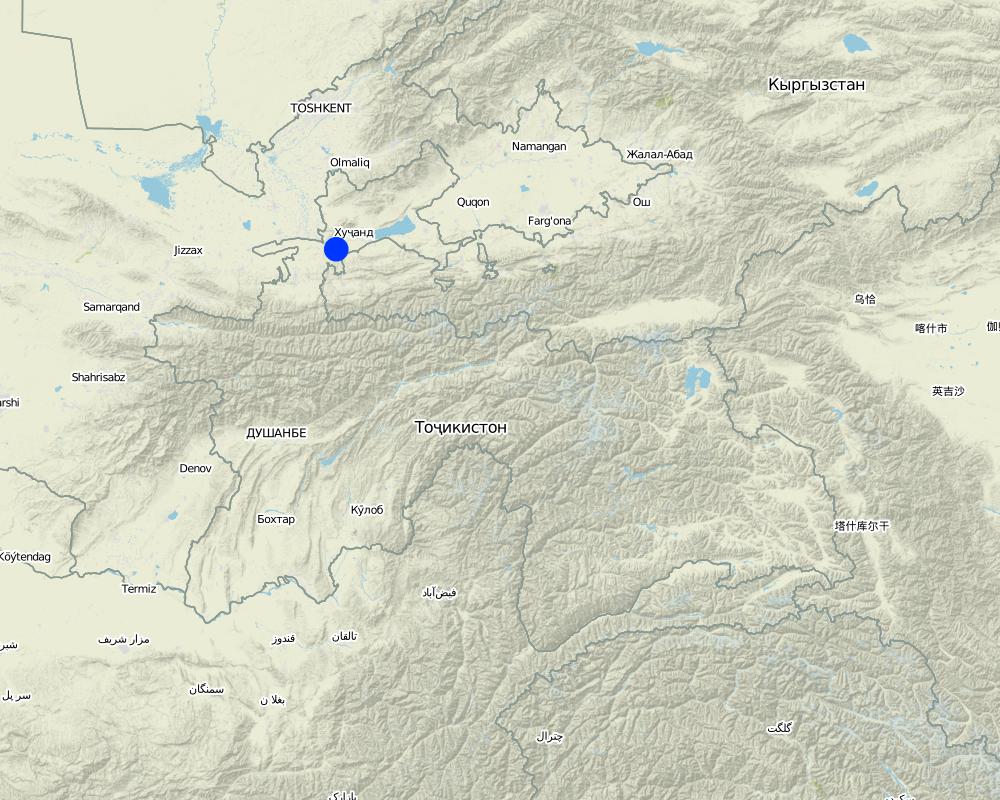Onion production by greenhouse propagation and transplantation [Tajikistan]
- Creation:
- Update:
- Compiler: Stefan Michel
- Editor: –
- Reviewer: Umed Vahobov
Выращивание лука рассадным способом
technologies_4296 - Tajikistan
View sections
Expand all Collapse all1. General information
1.2 Contact details of resource persons and institutions involved in the assessment and documentation of the Technology
Key resource person(s)
SLM specialist:
Negmatov Negmatjon
Deutsche Gesellschaft für Internationale Zusammenarbeit (GIZ)
Tajikistan
SLM specialist:
Haydarov Abdusattor
NGO Neksigol
Tajikistan
1.3 Conditions regarding the use of data documented through WOCAT
The compiler and key resource person(s) accept the conditions regarding the use of data documented through WOCAT:
Yes
1.4 Declaration on sustainability of the described Technology
Is the Technology described here problematic with regard to land degradation, so that it cannot be declared a sustainable land management technology?
No
1.5 Reference to Questionnaire(s) on SLM Approaches (documented using WOCAT)
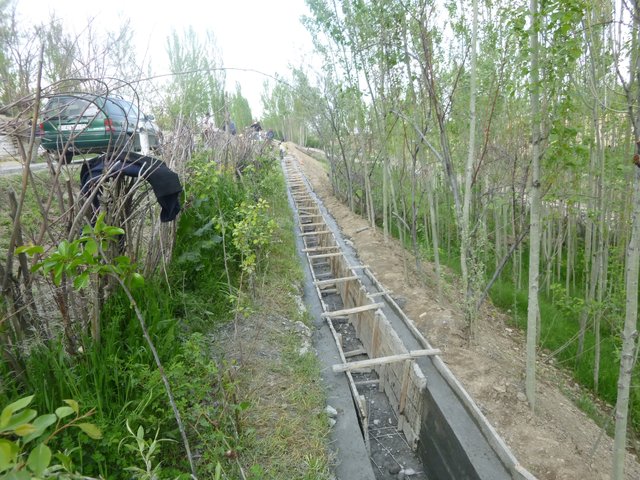
Increased efficiency of irrigation water use to address … [Tajikistan]
Climate change impact contributes to irrigation water shortage. The approach of improving irrigation water delivery, distribution and use prevents irrigation water losses and increases the productivity per amount of irrigation water available.
- Compiler: Stefan Michel
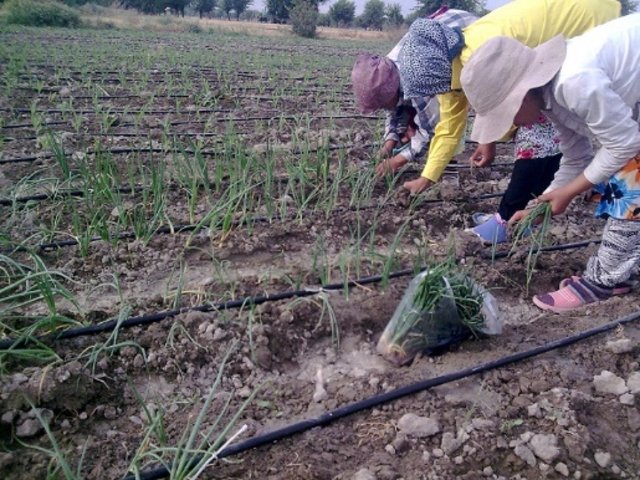
Integrated farming on irrigated lands for adaptation to … [Tajikistan]
Irrigated agriculture faces challenges from climate change impact and growing competition for irrigation water. The approach to get "more crop per drop" reduces the adverse effect of these impacts and improves the income of farmers.
- Compiler: Stefan Michel
2. Description of the SLM Technology
2.1 Short description of the Technology
Definition of the Technology:
Onion seeds are sown in sheeting greenhouses, where the onion seedlings are propagated. The seedlings are then replanted in the open field. This makes them less prone to extreme weather events and provides higher yield of better quality.
2.2 Detailed description of the Technology
Description:
The technology of greenhouse propagation of onion plants and transplantation is applied in intensive, irrigation dependent agricultural systems. The technology is based on sowing of onion seeds in a sheeting greenhouse, where the seedlings grow for 45 days. Afterwards the onion seedlings are replanted in the open field. By this technology the sensitive seedlings are propagated in a protective environment making them less vulnerable to unfavorable weather conditions, like late freezing or rainstorms. Due to ongoing climate change weather conditions become less predictable and extreme events become more frequent.
The propagation of onions in the greenhouse requires substantially less seeds than traditional hand sowing in the field – 4 kg/ha onion field instead of 16-18 kg, i.e. saving 75-77%. Furthermore the propagation of onion seedlings in greenhouses with transplanting allows for a reduced input of pesticides and fertilizer compared to sowing in the field. This reduction of agrochemical input is related to the small area and favorable conditions in the greenhouse during the propagation of the seedlings.
The technology requires the preparation of the field in fall with 30 cm deep ploughing, harrowing and planning (молование). Afterwards the furrows for planting are made. Complex mineral fertilizer “NitroAmmoPhosKa” (N 16%, P2O5 16%, K2O 16%) or “DiAmmoPhosKa” (N 16%, P 16%, K 16%) in an amount of 75 kg per ha is applied before the transplanting.
The onion seeds are in mid-March sown in a sheeting greenhouse with 4 kg seeds on 100 m². Together with the seeds 3 kg “NitroAmmoPhosKa” and some dung are applied as fertilizer. After 45 days the onion seedlings have reached the stage of three real leaves and are in their optimum growth stage for replanting into the field. The seedlings in the three-leaf stage are by hand planted on the open ground of the prepared as described field.
During the growth period the seedlings are one time weeded and fertilized as follows: i) during planting 75 kg/ha “NitroAmmoPhosKa” is applied; ii) another 100 kg/ha “NitroAmmoPhosKa” is applied in form of supplementary fertilizing (подкормка). Also other fertilizer has been applied in form of supplementary fertilizing (подкормка) 400 kg/ha “Selitra”, 200 kg/ha “Ammophos” and 200 kg/ha “Karbamid (46)”. The onion has also been treated with various pesticides. The field is 10 times irrigated during the vegetation season, requiring 8000 m³ of irrigation water.
The yield on test plots was 91,300 kg/ha. The harvested onions are more homogenous in size thus better marketable than those propagated conventionally.
The benefit of the technology is the reduced amount of seeds required, reduced costs of pesticides and fertilizer. Despite the costs of materials and the effort needed to establish the greenhouse and the additional work for transplanting the seedlings, the technology provides an economic net benefit to the farmer. In testing plots the net profit of traditional onion cultivation was 76% while with greenhouse propagation and transplanting a net profit of 192% would be achieved. Greenhouse propagation also protects the seedlings from failure caused by extreme weather events, which become more frequent due to climate change, and thus reduce the risk for the farmers.
2.3 Photos of the Technology
2.5 Country/ region/ locations where the Technology has been applied and which are covered by this assessment
Country:
Tajikistan
Region/ State/ Province:
Sughd region
Further specification of location:
J. Rasulov district
Specify the spread of the Technology:
- applied at specific points/ concentrated on a small area
Is/are the technology site(s) located in a permanently protected area?
No
Comments:
So far only single farmers apply the technology.
Map
×2.6 Date of implementation
Indicate year of implementation:
2016
2.7 Introduction of the Technology
Specify how the Technology was introduced:
- during experiments/ research
- through projects/ external interventions
Comments (type of project, etc.):
Demonstration plots have been established and monitored by the NGO Neksigol with support by the GIZ project.
3. Classification of the SLM Technology
3.1 Main purpose(s) of the Technology
- improve production
- adapt to climate change/ extremes and its impacts
- create beneficial economic impact
3.2 Current land use type(s) where the Technology is applied
Land use mixed within the same land unit:
No

Cropland
- Annual cropping
Annual cropping - Specify crops:
- cereals - wheat (spring)
- fibre crops - cotton
- oilseed crops - sunflower, rapeseed, other
- vegetables - root vegetables (carrots, onions, beet, other)
Number of growing seasons per year:
- 1
Is crop rotation practiced?
Yes
3.3 Has land use changed due to the implementation of the Technology?
Has land use changed due to the implementation of the Technology?
- No (Continue with question 3.4)
3.4 Water supply
Water supply for the land on which the Technology is applied:
- full irrigation
3.5 SLM group to which the Technology belongs
- improved plant varieties/ animal breeds
- imoroved vegetable cultivation
3.6 SLM measures comprising the Technology

agronomic measures
- A5: Seed management, improved varieties
- A7: Others
3.8 Prevention, reduction, or restoration of land degradation
Specify the goal of the Technology with regard to land degradation:
- not applicable
4. Technical specifications, implementation activities, inputs, and costs
4.2 General information regarding the calculation of inputs and costs
Specify how costs and inputs were calculated:
- per Technology area
Indicate size and area unit:
hectare
other/ national currency (specify):
TJS
If relevant, indicate exchange rate from USD to local currency (e.g. 1 USD = 79.9 Brazilian Real): 1 USD =:
8.0
Indicate average wage cost of hired labour per day:
20-50
4.4 Costs and inputs needed for establishment
Comments:
We did not differentiate establishment and recurrent activities, as this is a technology to be integrated in the overall cycle of agricultural works.
4.5 Maintenance/ recurrent activities
| Activity | Timing/ frequency | |
|---|---|---|
| 1. | Preparation of greenhouse field (100 m²) | February-March/once per annum |
| 2. | Establishment of sheeting greenhouse | February-March/once per annum |
| 3. | Sowing onion seeds and care | March-April/once per annum |
| 4. | Transplanting of seedlings | End April/once per annum |
| 5. | Ploughing of field, harrowing, planning, making furrows | Before transplanting/once per annum |
| 6. | Fertilizing | Before transplanting, during vegetation |
| 7. | Irrigation | 10 times during vegetation season |
| 8. | Application of pesticides | 5 times during vegetation season |
| 9. | Weeding | 3 times during vegetation season |
| 10. | Harvest | Once per annum |
Comments:
We did not differentiate establishment and recurrent activities, as this is a technology to be integrated in the overall cycle of agricultural works.
4.6 Costs and inputs needed for maintenance/ recurrent activities (per year)
| Specify input | Unit | Quantity | Costs per Unit | Total costs per input | % of costs borne by land users | |
|---|---|---|---|---|---|---|
| Labour | Preparation of greenhouse field (100 m²) | person | 1.0 | 50.0 | 50.0 | 100.0 |
| Labour | Establishment of greenhouse | person | 1.0 | 50.0 | 50.0 | 100.0 |
| Labour | Sowing onion seeds and care (over 45 days) | person | 2.0 | 50.0 | 100.0 | 100.0 |
| Labour | Agrotechnical works | ha | 1.0 | 820.0 | 820.0 | 100.0 |
| Equipment | Sheeting | m | 50.0 | 1.0 | 50.0 | 100.0 |
| Plant material | Seeds | kg | 4.0 | 685.0 | 2740.0 | 100.0 |
| Plant material | Transplanting | 1.0 | 1520.0 | 1520.0 | 100.0 | |
| Fertilizers and biocides | Politrin ka | l | 1.0 | 200.0 | 200.0 | 100.0 |
| Fertilizers and biocides | Mospilan | kg | 0.4 | 100.0 | 40.0 | 100.0 |
| Fertilizers and biocides | Goal | l | 0.6 | 220.0 | 132.0 | 100.0 |
| Fertilizers and biocides | Other pesticides | Total | 1.0 | 2371.0 | 2371.0 | 100.0 |
| Fertilizers and biocides | Ammonium Nitrate | 50 kg | 8.0 | 120.0 | 960.0 | 100.0 |
| Fertilizers and biocides | NitroAmmoPhosKa | 50 kg | 4.8 | 240.0 | 1152.0 | 100.0 |
| Fertilizers and biocides | Ammophos | 50 kg | 4.0 | 160.0 | 640.0 | 100.0 |
| Fertilizers and biocides | Karbamid (46) | 50 kg | 4.0 | 130.0 | 520.0 | 100.0 |
| Construction material | 2.0 | |||||
| Other | Irrigation | times | 10.0 | 50.0 | 500.0 | 100.0 |
| Other | Irrigation water | m³ | 8000.0 | 0.018 | 144.0 | 100.0 |
| Other | Application of pesticides | times | 5.0 | 50.0 | 250.0 | 100.0 |
| Other | Weeding | times | 3.0 | 500.0 | 1500.0 | 100.0 |
| Other | Harvest | ha | 1.0 | 4000.0 | 4000.0 | 100.0 |
| Other | Miscellaneous expenses | 1.0 | 1000.0 | 1000.0 | 100.0 | |
| Total costs for maintenance of the Technology | 18739.0 | |||||
| Total costs for maintenance of the Technology in USD | 2342.38 | |||||
Comments:
We did not differentiate establishment and recurrent activities, as this is a technology to be integrated in the overall cycle of agricultural works.
4.7 Most important factors affecting the costs
Describe the most determinate factors affecting the costs:
Transplanting is an important additional cost factor, compared to conventional sowing. However, costs for seeds is lower despite of use of higher quality seeds of certified sorts.
5. Natural and human environment
5.1 Climate
Annual rainfall
- < 250 mm
- 251-500 mm
- 501-750 mm
- 751-1,000 mm
- 1,001-1,500 mm
- 1,501-2,000 mm
- 2,001-3,000 mm
- 3,001-4,000 mm
- > 4,000 mm
Specify average annual rainfall (if known), in mm:
246.00
Indicate the name of the reference meteorological station considered:
Mehrobod
Agro-climatic zone
- semi-arid
5.2 Topography
Slopes on average:
- flat (0-2%)
- gentle (3-5%)
- moderate (6-10%)
- rolling (11-15%)
- hilly (16-30%)
- steep (31-60%)
- very steep (>60%)
Landforms:
- plateau/plains
- ridges
- mountain slopes
- hill slopes
- footslopes
- valley floors
Altitudinal zone:
- 0-100 m a.s.l.
- 101-500 m a.s.l.
- 501-1,000 m a.s.l.
- 1,001-1,500 m a.s.l.
- 1,501-2,000 m a.s.l.
- 2,001-2,500 m a.s.l.
- 2,501-3,000 m a.s.l.
- 3,001-4,000 m a.s.l.
- > 4,000 m a.s.l.
Indicate if the Technology is specifically applied in:
- not relevant
5.3 Soils
Soil depth on average:
- very shallow (0-20 cm)
- shallow (21-50 cm)
- moderately deep (51-80 cm)
- deep (81-120 cm)
- very deep (> 120 cm)
Soil texture (topsoil):
- medium (loamy, silty)
Soil texture (> 20 cm below surface):
- medium (loamy, silty)
Topsoil organic matter:
- medium (1-3%)
5.4 Water availability and quality
Ground water table:
< 5 m
Availability of surface water:
medium
Water quality (untreated):
for agricultural use only (irrigation)
Water quality refers to:
both ground and surface water
Is water salinity a problem?
No
Is flooding of the area occurring?
No
5.5 Biodiversity
Species diversity:
- low
Habitat diversity:
- low
5.6 Characteristics of land users applying the Technology
Sedentary or nomadic:
- Sedentary
Market orientation of production system:
- commercial/ market
Relative level of wealth:
- average
Individuals or groups:
- individual/ household
- cooperative
Level of mechanization:
- mechanized/ motorized
Gender:
- women
- men
Age of land users:
- youth
- middle-aged
5.7 Average area of land used by land users applying the Technology
- < 0.5 ha
- 0.5-1 ha
- 1-2 ha
- 2-5 ha
- 5-15 ha
- 15-50 ha
- 50-100 ha
- 100-500 ha
- 500-1,000 ha
- 1,000-10,000 ha
- > 10,000 ha
Is this considered small-, medium- or large-scale (referring to local context)?
- medium-scale
Comments:
Technology can be applied by small-holders as well as by large farms.
5.8 Land ownership, land use rights, and water use rights
Land ownership:
- state
Land use rights:
- leased
- Water management organization
Are land use rights based on a traditional legal system?
No
5.9 Access to services and infrastructure
health:
- poor
- moderate
- good
education:
- poor
- moderate
- good
technical assistance:
- poor
- moderate
- good
employment (e.g. off-farm):
- poor
- moderate
- good
markets:
- poor
- moderate
- good
energy:
- poor
- moderate
- good
roads and transport:
- poor
- moderate
- good
drinking water and sanitation:
- poor
- moderate
- good
financial services:
- poor
- moderate
- good
6. Impacts and concluding statements
6.1 On-site impacts the Technology has shown
Socio-economic impacts
Production
crop production
Quantity before SLM:
40.000 kg/ha
Quantity after SLM:
91,300 kg/ha
crop quality
Comments/ specify:
Higher percentage of onions of standard size and quality
Income and costs
expenses on agricultural inputs
Comments/ specify:
Reduction of fertilizer application: by 50% (400 kg) Ammonium Nitrate and 52% (260 kg) NitroAmmoPhosKa
farm income
Quantity before SLM:
14,266 TJS/ha
Quantity after SLM:
36.041 TJS/ha
Comments/ specify:
The net profit while applying this technololgy is 192% of the costs, compared with 76% with applying conventional methods.
Ecological impacts
Other ecological impacts
Onion seedlings less prone to extreme weather events, like late freezing and snow
6.3 Exposure and sensitivity of the Technology to gradual climate change and climate-related extremes/ disasters (as perceived by land users)
Climate-related extremes (disasters)
Meteorological disasters
| How does the Technology cope with it? | |
|---|---|
| local rainstorm | well |
| local snowstorm | well |
| local windstorm | not well |
Climatological disasters
| How does the Technology cope with it? | |
|---|---|
| cold wave | very well |
6.4 Cost-benefit analysis
How do the benefits compare with the establishment costs (from land users’ perspective)?
Short-term returns:
positive
Long-term returns:
positive
How do the benefits compare with the maintenance/ recurrent costs (from land users' perspective)?
Short-term returns:
positive
Long-term returns:
positive
6.5 Adoption of the Technology
- 1-10%
Of all those who have adopted the Technology, how many did so spontaneously, i.e. without receiving any material incentives/ payments?
- 91-100%
6.6 Adaptation
Has the Technology been modified recently to adapt to changing conditions?
No
6.7 Strengths/ advantages/ opportunities of the Technology
| Strengths/ advantages/ opportunities in the compiler’s or other key resource person’s view |
|---|
| Reduced risk, reduced amount of seeds |
| Increased yield of better quality |
| As onion is an important crop in the area there is high potential for the application of the technology |
6.8 Weaknesses/ disadvantages/ risks of the Technology and ways of overcoming them
| Weaknesses/ disadvantages/ risks in the compiler’s or other key resource person’s view | How can they be overcome? |
|---|---|
| None | |
| High workload required for transplanting | Adequate organization of farm works. Attraction of temporary labor. |
| Sheeting of greenhouses only suitable for one season, no recycling opportunities - risk of massive littering of the environment. | Establishment of system for collection of used sheeting and its recycling or energetic use. |
7. References and links
7.1 Methods/ sources of information
- field visits, field surveys
- interviews with SLM specialists/ experts
- compilation from reports and other existing documentation
Documentation by the project: information sheet, excel files for calculation of gross margin specifying inputs and yield.
When were the data compiled (in the field)?
29/11/2018
Links and modules
Expand all Collapse allLinks

Increased efficiency of irrigation water use to address … [Tajikistan]
Climate change impact contributes to irrigation water shortage. The approach of improving irrigation water delivery, distribution and use prevents irrigation water losses and increases the productivity per amount of irrigation water available.
- Compiler: Stefan Michel

Integrated farming on irrigated lands for adaptation to … [Tajikistan]
Irrigated agriculture faces challenges from climate change impact and growing competition for irrigation water. The approach to get "more crop per drop" reduces the adverse effect of these impacts and improves the income of farmers.
- Compiler: Stefan Michel
Modules
No modules


